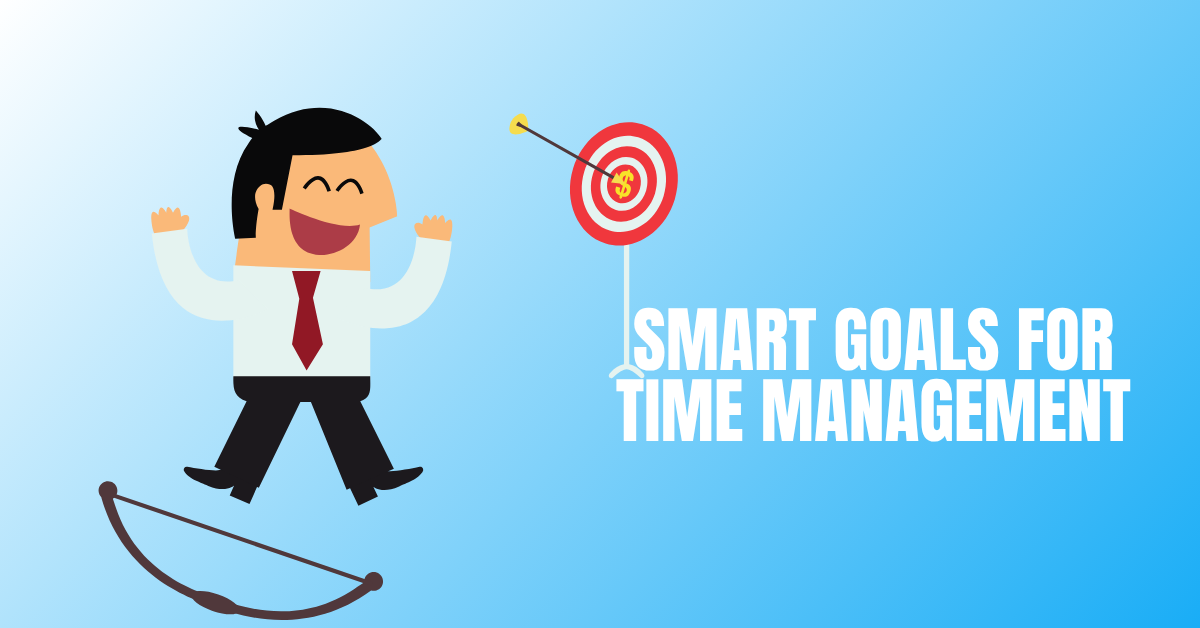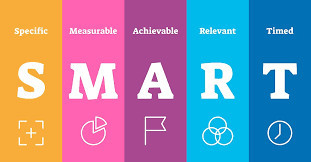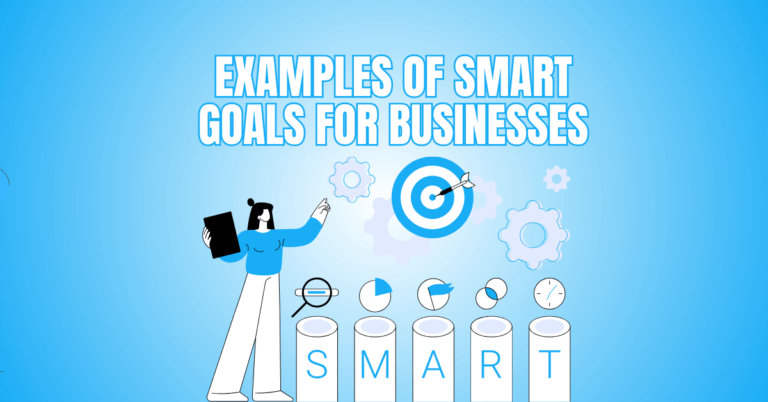SMART Goals For Time Management That Supercharge Success
Setting SMART Goals for Time Management is essential to boosting your productivity and achieving your ambitions.
Setting goals that are Specific, Measurable. Achievable, Relevant, Time-bound, help you make a clear strategy that directs your daily activities.
This method helps eliminate procrastination, prioritize tasks, and manage your time effectively, ensuring that every effort counts toward reaching your success faster and with greater confidence.
How To Set SMART Goals For Time Management
Setting SMART goals for time management helps you stay focused, organized, and productive. Here’s a clear step-by-step guide on how to set SMART goals effectively:
1. Specific
A goal must be crystal clear, leaving no room for ambiguity. Vague goals like “be more productive” are difficult to pursue because they lack direction.
Instead, define precisely what you want to achieve and why. Ask yourself: What task am I trying to complete? Why is it important? Who is involved? Where will it happen? How will I do it?
A specific time management goal could be: “I want to reduce distractions during work hours by limiting social media use.” This gives your brain a focused mission, allowing you to plan strategies and measure success more easily.
Key Points
- Define what, why, how, when, and where
- Avoid vague goals
- Directs your energy toward focused action
- Sets a strong foundation
2. Measurable
A goal without a way to track progress can easily fall apart. To stay motivated and accountable, you need measurable criteria. Add numbers, time limits, or frequency to your goal.
For instance, “Work on my writing project for 2 hours daily from 8–10 AM” is measurable, while “Work more on writing” is not.
Measurability helps you monitor how close you are to achieving your goal and when adjustments are necessary. Consider using timers, calendars, or apps like Trello or Notion to log and visualize progress. This turns your goal into something tangible and trackable, increasing your chances of success.
Key Points
- Attach numbers or milestones
- Use timers, calendars, or apps
- Enables progress tracking
- Keeps you accountable and motivated
3. Achievable
Being ambitious is great, but your goal must also be realistic given your current workload, time, and resources. An achievable goal balances challenge with possibility.
For example, if you currently spend 5 hours scrolling social media each day, aiming to eliminate it overnight isn’t sustainable.
Instead, start with something you can reasonably commit to, like reducing usage to 1 hour daily for a week. This builds confidence and momentum.
Review your obligations and capabilities honestly, and set a goal that stretches you without overwhelming you. Consistency, not perfection, leads to meaningful improvements in time management over time.
Key Points
- Be honest about what’s doable
- Avoid overwhelming yourself
- Start small to build momentum
- Balance challenge with realism
4. Relevant
Setting SMART goals for time management ensures your efforts align with your values, helping you stay focused and motivated on what truly matters.
Don’t chase productivity for productivity’s sake. Instead, connect your time-saving goals to something important, like academic success, career growth, or personal well-being.
For example: “I’ll wake up at 6:30 AM on weekdays to have time for morning workouts and start my day energized.” This habit supports both health and productivity.
When a goal feels meaningful and connected to your purpose, you're more likely to stay committed, even when distractions or low motivation kick in.
Key Points
- Align goals with values and priorities
- Filter out low-value tasks
- Stay motivated with purpose-driven actions
- Focus on meaningful results.
5. Time-Bound
A deadline creates urgency and motivates action. Without a time frame, your goal remains a wish. A time-bound goal includes a clear deadline or schedule, so you know when it starts, how long it lasts, and when it ends.
For example: “I will implement my new time management routine starting Monday and stick to it for the next 21 days.” Short-term deadlines can be motivating and help build habits.
Add regular check-in points (e.g., weekly reviews) to assess what’s working. Time limits not only guide your pace but also help you prevent procrastination and measure results more effectively.
Key Points
- Include start and end times
- Prevents endless delays
- Creates urgency and focus
- Enables review and realignment
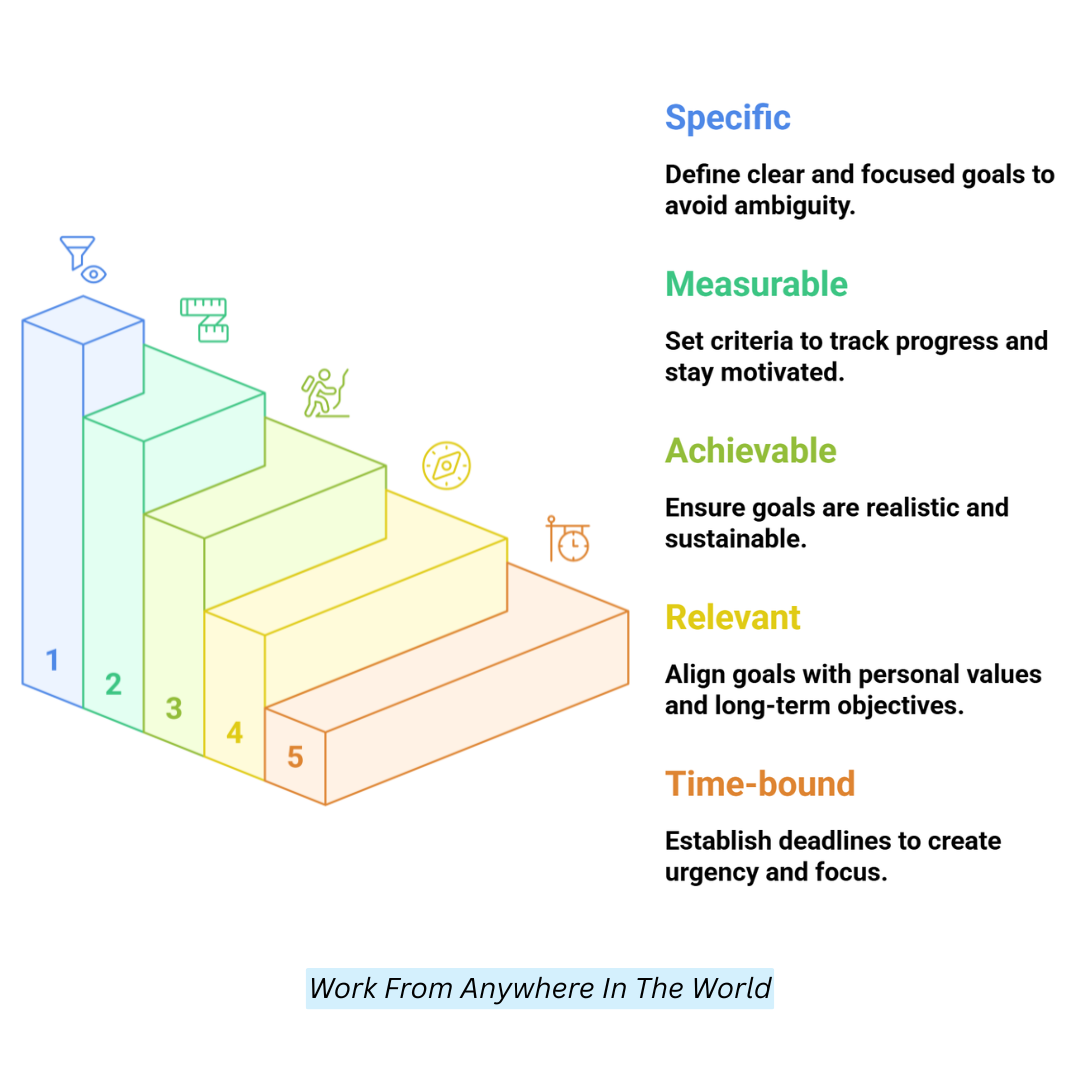
Examples Of SMART Time Management Goals
Effective time management begins with clear, actionable goals. Using the SMART framework helps you stay focused, organized, and productive. Here are eight SMART time management goal examples with practical steps.
1. Complete Daily Tasks Before 6 PM
To improve work-life balance, I will finish all my daily work tasks by 6:00 PM every weekday for the next month. I’ll start each day by listing key priorities, estimating how long each will take, and scheduling them in blocks on my calendar.
This SMART goal for time management helps improve work-life balance by prioritizing tasks, planning effectively, and maintaining focus within set work hours.
This SMART goal helps me stay productive during work hours while ensuring I have time for personal well-being and relaxation in the evenings.
2. Reduce Time Spent On Social Media
I'll limit my social media use to 30 minutes a day for the next three weeks in order to make up lost time. First, I’ll install a screen time tracker such as Digital Wellbeing or Forest to monitor current usage.
Then, I’ll set daily app limits and remove notifications that lead to distractions. I’ll schedule short, intentional breaks for social media—perhaps during lunch or evening.
During freed-up time, I’ll replace scrolling with productive or relaxing activities like reading or walking. This goal is Specific, Measurable, and Time-bound, allowing me to cut digital distractions and gain better control of my daily schedule.
3. Plan A Weekly Schedule Every Sunday
To stay organized and proactive, I will plan my weekly schedule every Sunday at 7:00 PM for the next two months. I’ll review my calendar, deadlines, meetings, and personal commitments.
Using a digital planner like Notion or Google Calendar, I’ll allocate time blocks for major tasks, prioritize urgent items, and leave room for unexpected events.
I’ll also reflect on what worked the previous week and adjust accordingly. This consistent habit will help me start each week with a clear direction, boost productivity, and reduce stress caused by disorganization or last-minute planning.
4. Prioritize Top 3 Tasks Daily
To enhance focus and reduce overwhelm, I will identify and complete my top 3 priority tasks each morning for the next four weeks.
I’ll start my day by writing these tasks in a planner or task app, ranking them based on importance and urgency. I’ll dedicate uninterrupted time blocks to each task, turning off distractions like emails or notifications during that period.
Completing high-impact tasks early ensures I achieve meaningful progress even if the rest of the day becomes unpredictable.
This strategy will improve decision-making, build momentum, and help me consistently make the most of my working hours.
Wealthy Affiliate – Mini Review (2025)
If you’ve ever thought about turning your blog, passion, or niche into an online business,
Wealthy Affiliate (WA) is one of the most beginner-friendly platforms I’ve used.
It combines step-by-step training, website hosting, SEO research tools,
and an active community all in one place.
What I like most: you can start free (no credit card needed),
explore lessons, test the tools, and connect with other entrepreneurs
before upgrading. WA isn’t a “get rich quick” scheme — it’s a platform where success comes
from consistent effort and applying what you learn.
5. Use The Time Blocking Method For 2 Weeks
To improve structure and efficiency, I will use the time-blocking technique from 9 AM to 5 PM, Monday to Friday, for the next two weeks.
Each morning, I’ll create a schedule that divides my day into focused blocks—for example, emails from 9–9:30, project work from 9:30–11:30, and meetings from 2–3.
Using SMART goals for time management, I’ll implement time-blocking daily to boost focus, reduce multitasking, and increase overall efficiency.
Time blocking helps me focus intensely on one task at a time, avoid multitasking, and make the most of my available hours.
6. Improve Meeting Efficiency
To save time and increase productivity, I will reduce all internal meetings to a maximum of 30 minutes and include clear agendas for the next 4 weeks.
Before each meeting, I’ll prepare and share an agenda outlining topics and time allocations. I’ll use tools like Google Docs or Notion for collaboration and ensure each meeting starts and ends on time.
I’ll also encourage using asynchronous updates where possible. This process ensures meetings are purposeful, reduces unnecessary discussions, and gives me more time to focus on actual work. It's a SMART way to make communication efficient and goal-oriented.
7. Track Time Spent On Tasks
To identify time leaks and improve efficiency, I will track how I spend my work hours daily for the next 30 days. I’ll use a time-tracking app like Toggl Track or Clockify to log time spent on tasks such as emails, meetings, creative work, and breaks.
At the end of each week, I’ll review the data to spot trends and areas where I’m wasting time. I’ll then adjust my workflow, reduce low-value activities, and reallocate time to more critical tasks. This method gives me measurable insight into my habits, helping me fine-tune how I manage my day.
8. Limit Email Checking To 3 Times Daily
For thirty days, I will only check and reply to emails three times a day, at nine in the morning, one in the afternoon, and four in the evening.
Outside these windows, I’ll turn off email notifications and avoid opening my inbox. This approach will help me minimize constant interruptions and improve my ability to focus on important tasks without distraction.
During each email session, I will batch process messages by urgency and importance, responding efficiently. By controlling when I engage with emails, I expect to boost productivity and maintain deeper concentration during my workday.
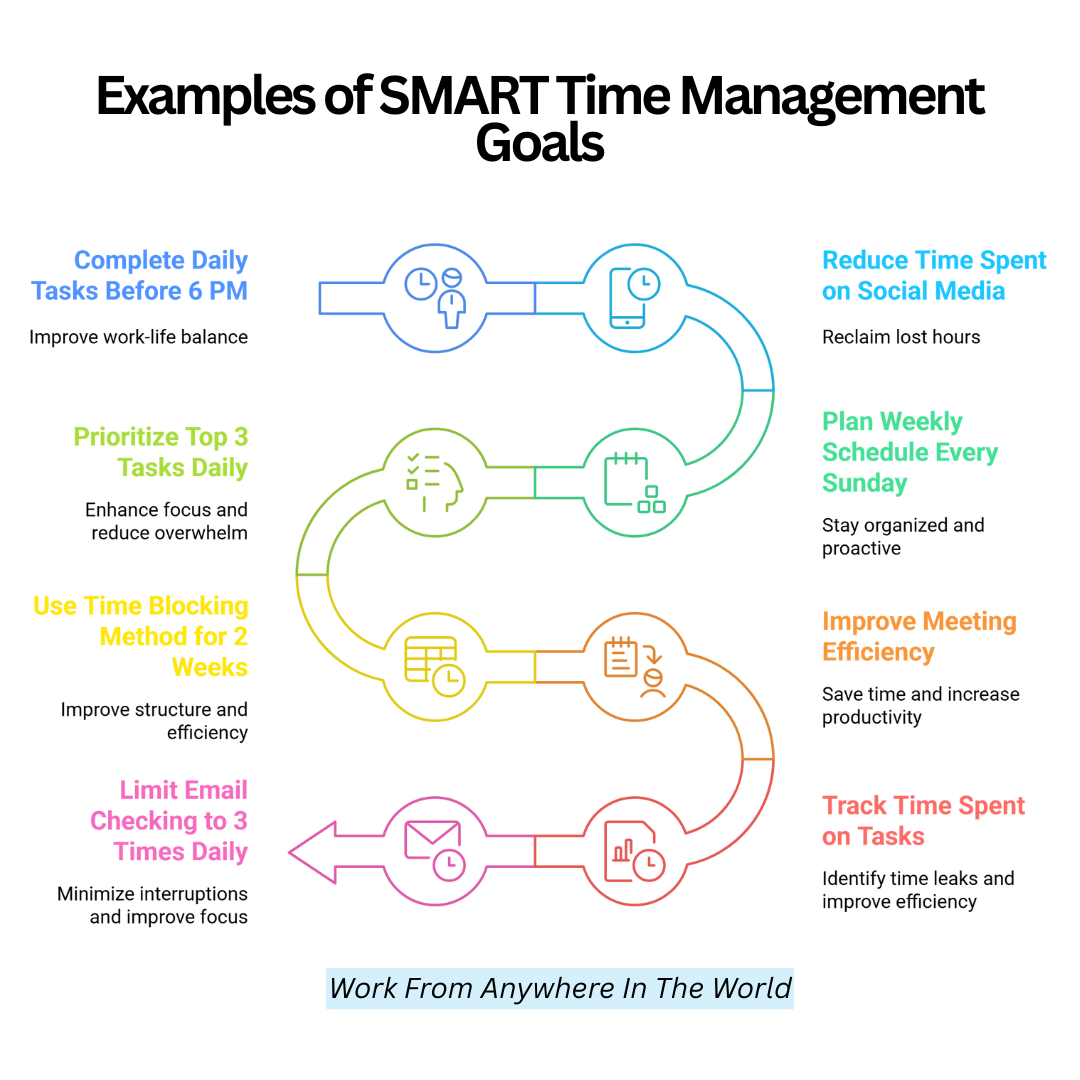
Tools And Techniques To Support Your SMART Goals
SMART goals for time management, combined with practical tools and techniques, empower you to stay focused and achieve your objectives consistently.
1. Time Tracking Apps
Time tracking apps like Toggl Track (free with paid plans from $10/month), RescueTime (starts at $12/month), or Clockify (free with premium options from $4.99/month) help you understand exactly where your time is going.
To use, start by creating projects or tasks related to your SMART goal. Turn on the timer when you begin working on a task and stop it when done.
Review the visual reports at the end of the day or week to spot time-wasting activities and adjust your work habits accordingly. This clarity helps you stay aligned with time-bound and measurable goals.
2. To-Do Lists
To-do lists help break your SMART goals into manageable tasks. Use Todoist (free with Pro at $4/month), Microsoft To Do (free), or even a paper planner.
Start by determining the essential actions required to accomplish your objective. Break those into daily or weekly tasks and prioritize based on urgency.
As you check items off, you build momentum and stay focused on what’s important. To-do lists bring structure and clarity to your plan, ensuring each part of your goal is addressed without becoming overwhelming.
3. Calendar Blocking
Calendar blocking helps allocate dedicated time slots for each task. Use tools like Google Calendar (free) or Microsoft Outlook (part of Microsoft 365, starts at $6.99/month).
Begin by listing your tasks, then drag and drop each into open slots on your daily calendar. Treat these blocks like appointments—non-negotiable and focused.
This technique helps manage distractions, reduces procrastination, and supports the time-bound nature of SMART goals. You visually see your plan unfold throughout the day and are less likely to overbook or forget essential milestones.
4. Pomodoro Technique
The Pomodoro Technique involves working for 25 minutes followed by a 5-minute break. After four rounds, take a more extended 15–30 minute break.
Apps like Focus Booster (free with paid plans from $2.99/month) or Pomofocus (free) help automate timing and track sessions.
This method enhances productivity by creating urgency and maintaining energy throughout the day. Set a timer, focus on one task, and resist checking notifications.
The short breaks prevent burnout while the structured intervals make tasks feel more manageable. It aligns well with SMART goals that require focused, consistent effort over time.
5. Accountability Partners
Having an accountability partner enhances SMART goals for time management by providing motivation, support, and honest feedback to help you stay committed and on track.
You don’t need to pay for this unless you hire a professional coach (can range from $50–$300 per session). Set clear expectations: decide how often to check in, what updates to share, and how to handle setbacks.
Having someone else involved creates external motivation and support, making it more likely that you’ll stay committed.
It strengthens the “Achievable” and “Relevant” aspects of SMART goals through mutual encouragement and honest feedback.
6. Habit Tracking Apps
Habit tracking apps like Habitica (free, premium $5/month) and Streaks ($4.99 one-time purchase) help turn goal-related behaviours into daily routines.
Start by defining small habits that contribute to your SMART goal. Log your progress daily, and watch your streaks grow, which motivates consistency.
Habitica gamifies progress by rewarding you for completing tasks, while Streaks offers a simple, clean interface for tracking.
Using these apps builds discipline and momentum by focusing on repetition. Over time, consistent habits create measurable improvements that make achieving your goals much more manageable.
7. Mind Mapping Tools
Mind mapping tools such as MindMeister (free basic, paid from $4.99/month) or XMind (free, pro $39.99/year) help visually organize and plan your SMART goals.
Begin by placing your main goal in the center, then create branches for tasks, deadlines, challenges, and resources. This process helps break complex goals into clear, actionable parts and stimulates creative thinking.
It provides an overview that enhances understanding and prioritization, ensuring no critical step is overlooked. Mind mapping fosters a holistic view, allowing you to connect ideas logically and stay motivated as you work towards your objectives.
8. Focus Music & Noise Apps
Apps like Noisli ($10 one-time purchase or subscription options) and Brain.fm (starts at $6.95/month) provide ambient sounds scientifically designed to boost concentration.
These apps offer customizable soundscapes—white noise, rain, or cafe sounds—that help drown out distractions. Simply select your preferred background noise and set a timer aligned with your work session.
This technique improves your ability to focus on tasks, reduces mental fatigue, and maintains productivity over more extended periods.
Using sound to create an optimal work environment complements other tools like the Pomodoro Technique to help you stay engaged with your SMART goal tasks.
9. Journaling Tools
Journaling is a powerful technique to reflect on your SMART goal progress. Digital journals like Day One ($3.99/month) or traditional paper journals allow you to record daily insights, challenges, and successes.
Dedicate 5–10 minutes each day to writing about what you accomplished, obstacles faced, and plans for the next steps.
Journaling tools support SMART goals for time management by enhancing self-awareness, tracking progress, and maintaining motivation through regular reflection and adjustment. It reinforces commitment by making progress visible and thoughtful.
10. Project Management Software
Project management apps like Asana (free basic, premium from $10.99/month) and Trello (free with premium starting at $5/month) are great for handling complicated or team-based SMART goals.
Begin by creating boards or projects for your goal, then break it into tasks with deadlines and assign responsibilities if working with others.
Use features like checklists, labels, and progress tracking to stay organized. These platforms enable communication, collaboration, and transparency, ensuring accountability and smooth progress.
Regularly update your project to reflect changes and celebrate completed tasks to maintain momentum toward goal achievement.
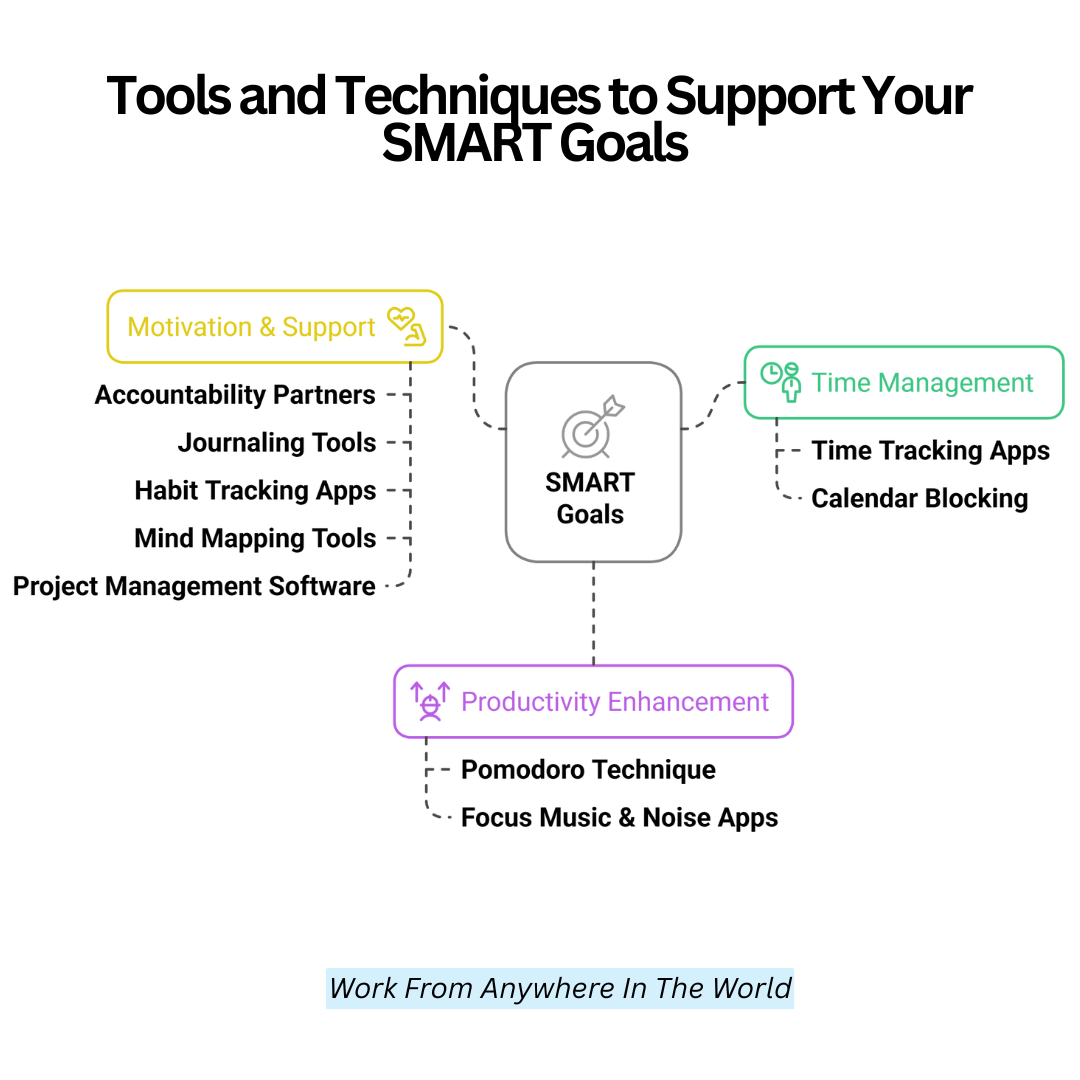
Conclusion
Incorporating SMART Goals for Time Management into your routine can genuinely transform your productivity and overall success.
Applying this framework regularly helps you stay motivated, focused, and on course to achieve your goals. The clarity and structure SMART goals provide empower you to overcome distractions and maximize your potential.
Start practicing SMART goal-setting today, and watch how it supercharges your ability to manage time and achieve your dreams with purpose.
I trust you enjoyed this article on the SMART Goals For Time Management That Supercharge Success. Please stay tuned for more insightful blogs on affiliate marketing, online business, and working from anywhere in the world.
Take care!
— JeannetteZ
💬 Your Opinion Is Important To Me
Do you have thoughts, ideas, or questions? I’d love to hear from you. Please leave your comments below or email me directly at Jeannette@WorkFromAnywhereInTheWorld.com.
📚 More Work From Anywhere Reads
🚀 Ready to Build a Business You Can Run from Home
Or from Anywhere in the World?
Imagine creating income on your terms — from home, a cozy café, or wherever life takes you.
With the right tools, training, and community support, it’s entirely possible.
Start your own online business for free — no credit card needed.
Disclosure
This post may contain affiliate links. As an Amazon Associate and participant in other affiliate programs, I earn from qualifying purchases at no extra cost to you. Please read my full affiliate disclosure.

